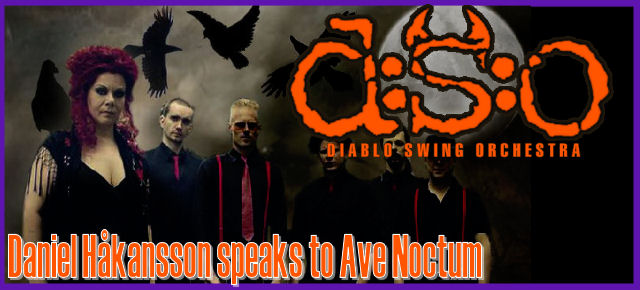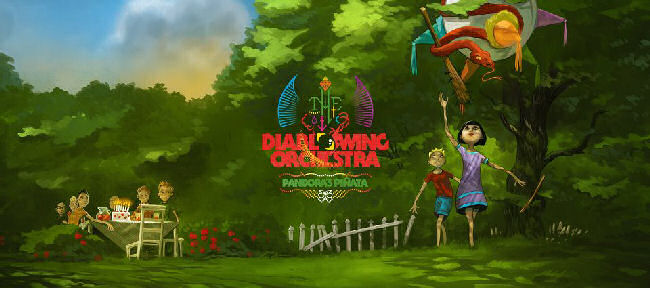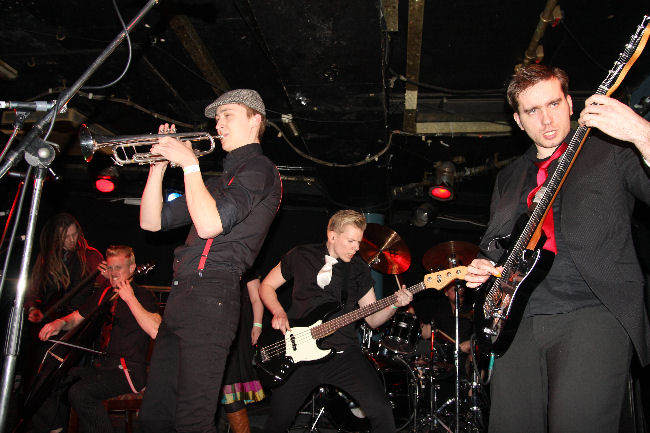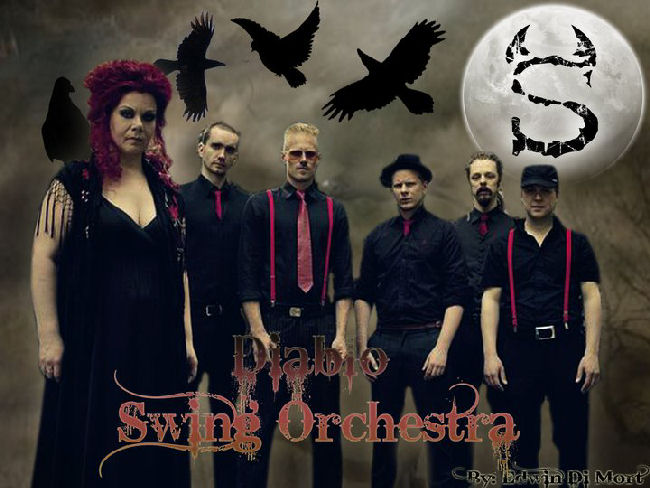The sound of Diablo Swing Orchestra is unique. Comprising a panoply of styles including swing jazz, classical, mariachi, metal and much more, they then combine them to create a host of moods but above all entertainment and fun. Coinciding with the release of their third album “Pandora’s Piñata”, Andrew Doherty interviewed guitarist and vocalist Daniel Håkansson to find out more about this octet of musicians.
AN: Hello Daniel. Thank you for taking the time to answer a few questions about Diablo Swing Orchestra. I must start by congratulating you. My wife, who normally listens to classical music and Chinese opera, heard me playing your albums and has claimed ownership of my prized copies. We also had a ball together when you played at the Camden Underworld in 2010. You have managed to bring us together musically. I’m sure this process must be going on in households everywhere. What’s your secret for achieving such a broad appeal?
DH: Well the appeal to non-metal heads would probably come from the fact that not many of us in the band listen to metal that much anymore. But it is all in our spine from our teens I guess so the appeal of heavy distorted guitars will always be there no matter what we listen to these days. The metal/rock ingredient in our music is just one among many so I guess we have a slightly different approach to writing songs than many other rock/metal band. In that sense we might play more world music than metal.
AN: How did you develop the idea of creating such a unique style of music?
DH: My mother was an aspiring opera singer and introduced me to the classical music world early on. She also has a really weird music taste and had me listen to it all and told what she felt while listening to it and why. I guess that was the embryo to how I starting to realise what tricks there are within composition to achieve certain effects.
AN: The story goes that Diablo Swing Orchestra is based historically on a troupe who travelled round Sweden entertaining the people in austere Lutheran times. If that is the case, have you any idea what the original music might have sounded like, and what inspiration has the story brought into the modern-day version of Diablo Swing Orchestra?
DH: Well it does create a nice foundation that you want to create something different and not your ordinary middle of the road kind of music.
AN: What’s the process when you create a song? Does one of you think “it’s time to have some swing, classical, Mexican, Indian, Chinese” or whatever, or does it work some other way?
DH: The “theme” or whatever you can call is always comes up after I have a good beat or melody. Then I try to see in what context that melody or beat would work. It can never be just for the sake of it.
AN: I sense that there is a “trademark” DSO sound, comprising cello-driven, tap dancing, jazz swing metal with classical elements – phew! I recognised this in “Voodoo Mon Amour”, the first track of “Pandora’s Piñata” and the two tracks which follow it. I know there’s no “rule” but the surprises seem to come later on the album. Of course not everyone will know what to expect in the first place. Do you start with a familiar pattern to get listeners comfortable and in the right mood?
DH: Well we are quite picky about the song order on the album and it is always picked so that the album will flow naturally. Guess some basic loose guidelines are that we need a strong bouncy opener, calm things down in the middle and round things off with a something of a little more epic nature. But those are absolutely not any rules that have to be followed.
AN: My guess is that you’ve all been music students at some point. Does the eclectic style of music reflect the tastes of individual members or do you all tend to see the progression of your music in the same way?
DH: Some of us have been and some haven’t. But we have all been playing in loads of different constellations before starting up DSO. We like to think we share sort of a common goal of when we have created something good and whenever someone on the band is not happy with a song or a certain passage of a song we always try to work around the problem and find a solution.
AN: To create the mayhem, movement and lightness that are so characteristic of your music, is it like a special sauce being added to a dish or is it a natural ingredient arising from the personality of the band members?
DH: We were all dropped once or twice as kids and this is the result…
AN: Do you try out different versions of your own songs?
DH: Well, we always change the arrangements for the live settings since we don’t use with backing tracks other than intros. But we haven’t done any complete different versions of our songs yet. Maybe if we get to play in a totally different context once. It would be a cool thing to try for sure!
AN: Do you surprise yourselves with your creativity and end result?
DH: Not so much with our own creativity. The funny thing with song writing is that you can’t always explain how you came up with something. And that process how you all of a sudden have a new song can be quite surprising when you can’t explain how you got there. And of course sometimes when you hear the finished version of a song you can’t be a bit surprised in a good or bad way when you get used to listening to the demo versions.
AN: A “piñata” is an object containing sweets which are gifts for children who knock them out with sticks. There’s an apparent contradiction here as Pandora’s box is about evil. What message are you conveying through the title of “Pandora’s Pinata”?
DH: We always try to do two things with all our titles to both songs and albums. We want the listener to get curious about the title and wonder what it can sound like and second, we want it to describe the song or album. We feel the album is full with contradictions just like the title and we always play around with the humorous and dark aspects of life in our songs.
AN: There’s always been a lurking dark side over your three albums to balance the overt joy. Do you look for a balance between the two, or is there no formula other than nature?
DH: Exactly, we like to use the two extremes since I think we can all relate to that. Most people have days of happiness and sadness and I think it therefore comes natural to us to express it in our music.
AN: Are image and colour very important to you? I say this because the sleeves of your new and previous albums have been strikingly colourful, and you have presented an image of yourself in red and black uniforms. The red and black could suggest a more dark and adult image. Is this a commercial image consciousness or do you deliberately set out to create conflicting images, and if so why?
DH: As for the album cover we once again want the listener to react and think; what is this?? To be honest we also want the cover to stand out a bit from other rock/metal releases. And the covers also mirrors the titles of the albums so I guess there is a bit of both commercial thinking and just being ourselves.
AN: The pictures on the sleeves of “Sing Along Songs for the Damned and Delirious” and “Pandora’s Piñata” suggest something childlike. The chorus of “Black Box Messiah” has a similar quality. Do you aim to cultivate an atmosphere of childhood innocence?
DH: I guess the children reference can refer to that as well but also to the fact that we write melodies we do like to use the simple but effective ways to capture the listener. If you break the songs down it’s not too complex stuff but instead rhythms and melodies a lot of people can relate to.
AN: Having listened to Pandora’s Piñata”, my impression was overall of less metal and of more different forms of music than on the two previous albums. Do you agree?
DH: Yes, we’ve never had the goal to solely be a metal band. As I said before metal is one part of the band and for this record it might not even be the main one. We like to create music and even though it sounds like a cliché we don’t like to have any genre boundaries to our songs. If it’s good music it’s good music.
AN: “Black Box Messiah” and its predecessor “How to Organise a Lynch Mob” on the new album are particularly interesting tracks because in amongst the upbeat music, the stringed section is quite sad. What was in your minds when you created this polarity of moods on these tracks?
DH: I had the rough idea for “black box messiah” laid down and I really wanted an intro for it and called Johannes (cello) and explained the idea I had and he took the melody from the refrain and created this lovely piece. We like to have intros as stand alones to our songs sort of to set a mood you either break or go along with for the rest of the song.
AN: How do you come up with your unusual track titles? “How to Organise a Lynch Mob” is an interesting title but how is it reflected by the music?
DH: It’s the same as with album titles. We want the title to grab the listener’s interest and make them wonder; what can this sound like. That title actually came from the fact that the guitar sounded like straight out of something fromTwin Peaks. And who directed that? David Lynch! Combine that with the kinda western feeling of the song where lynch mobs were common. So there you go 😉
AN: I wouldn’t say you’ve exploited the melancholic power of the violin and cello in the past. You’ve tended to use them for power and energy. I sensed a new development on “Justice for Saint Mary”, the final track of “Pandora’s Piñata”. It’s highbrow, melancholic, acoustic, dramatic and has a magnificently imaginative end. Great track! There’s always been feeling in the air, but until this album melancholy is not something I have previously associated with your work. Is this more serious side a new direction for Diablo Swing Orchestra?
DH: Thanks, maybe not a new direction as such but of course in order to keep things fresh you need to explore new territories and we are all very happy with how that song turned out so we will most likely explore the melancholic side of our sound further on upcoming albums.
AN: Another striking feature of “Justice for Saint Mary” and “Honey Trap Aftermath” is their soundtrack qualities. The jazz-trumpet infused “Honey Trap Aftermath” makes me think of cartoon adventures and even “The Jungle Book” while “Justice for Saint Mary” has the ambiance of a James Bond film or a thriller. Have you ever thought of using your music to branch out into other entertainment media?
DH: We have gotten some offers for small independent films but nothing major. I do have a plan to start writing film scores myself when I get too old to be on the road.
AN: You have at your disposal an impressive range of vocals, including an opera singer who sometimes is the focal point for songs, where on others such as the mystical “Mass Rapture” she comes in to add an extra dimension. How do you decide on the appropriate vocal input?
DH: It all depends on the song and we sometimes try out who it fits the best but normally I have clear idea of who will sing what when I start writing the songs nowadays. On the first record it was however more of an accident that I started singing since the idea was that Annlouice would sing everything but some passages didn’t sound right so I gave it a try and we felt it worked.
AN: You’ve increased your core membership to 6 from 8. What do the two extra members provide?
DH: Lots!! The collective skill level with these two guys is amazing. Besides the obvious contribution with providing us with a broader range of sounds for the songs they also worked a lot on the overall arrangements for all of the songs. That and the fact that they are lovely guys that we like to hang out with.
AN: Live performance is evidently a very important part of what you do and must involve a lot of preparation, given the small stages and number of you that there are. Has a stage ever been too small for you?
DH: Many times =) I think we’ve kinda gotten used to the fact that we don’t fit anywhere and always try to do the best of every situation.
AN: You about to perform in South America. Do you change your set list to suit local styles and tastes?
DH: Nah, not really. We always try to put together a set list that will be the best possible. It has more to do with if we’re the full band or if someone is missing or if we can bring all the instruments needed because of costs.
AN: You’ve played in a lot of different places and at a wide range of events, including Brutal Assault and ProgPower USA. Do you find that audience reactions differ depending on where you go?
DH: If I allow myself to generalize a bit we’ve had two kinds of crowds; one that is extremely sceptical and we have to win over or a really enthusiastic one that know all the words to every song. Both kind of crowd can be a challenge in their own way, for the people that really like the music and might have travelled extremely far to see you don’t wanna let them down. And the other kind of crowd there is just a lot of hard work to win them over.
AN: Apart from touring, how else are you promoting Diablo Swing Orchestra’s music and letting the world know that you’re out there?
DH: That would be primarily though facebook these days I’d say. We’re on other platforms as well but not nearly as active.
AN: I understand that “Voodoo Mon Amour” is being released as a single. Singles are not as common as they once were. What’s the strategy behind releasing a single?
DH: We wanted to give a taste of what’s to come since there was quite a lot of anticipation for the album to come out.
AN: It’s more than clear that you’re happy to experiment. Have you ever thought of covering someone else’s music?
DH: Yes, many times. But so far the ideas I’ve had for covers have been put together to original songs =) But I’m sure we will do one sooner or later. It’s always a challenge to try out other people’s music and try to do it your own.
AN: What other ideas and projects do you have in mind for the future?
DH: For me I have enough to keep me occupied but there are other projects going on which people should check out.
AN: To finish, is there anything you would like to say to our readers
DH: Stay swinging and buy our album!
Interview Andrew Doherty
Live Photo Pete Woods





19/07/2012 at 11:26 am
Great read this, well done with the questions Andrew. Let’s hope will get the chance to swing with them on on some UK dates soon.